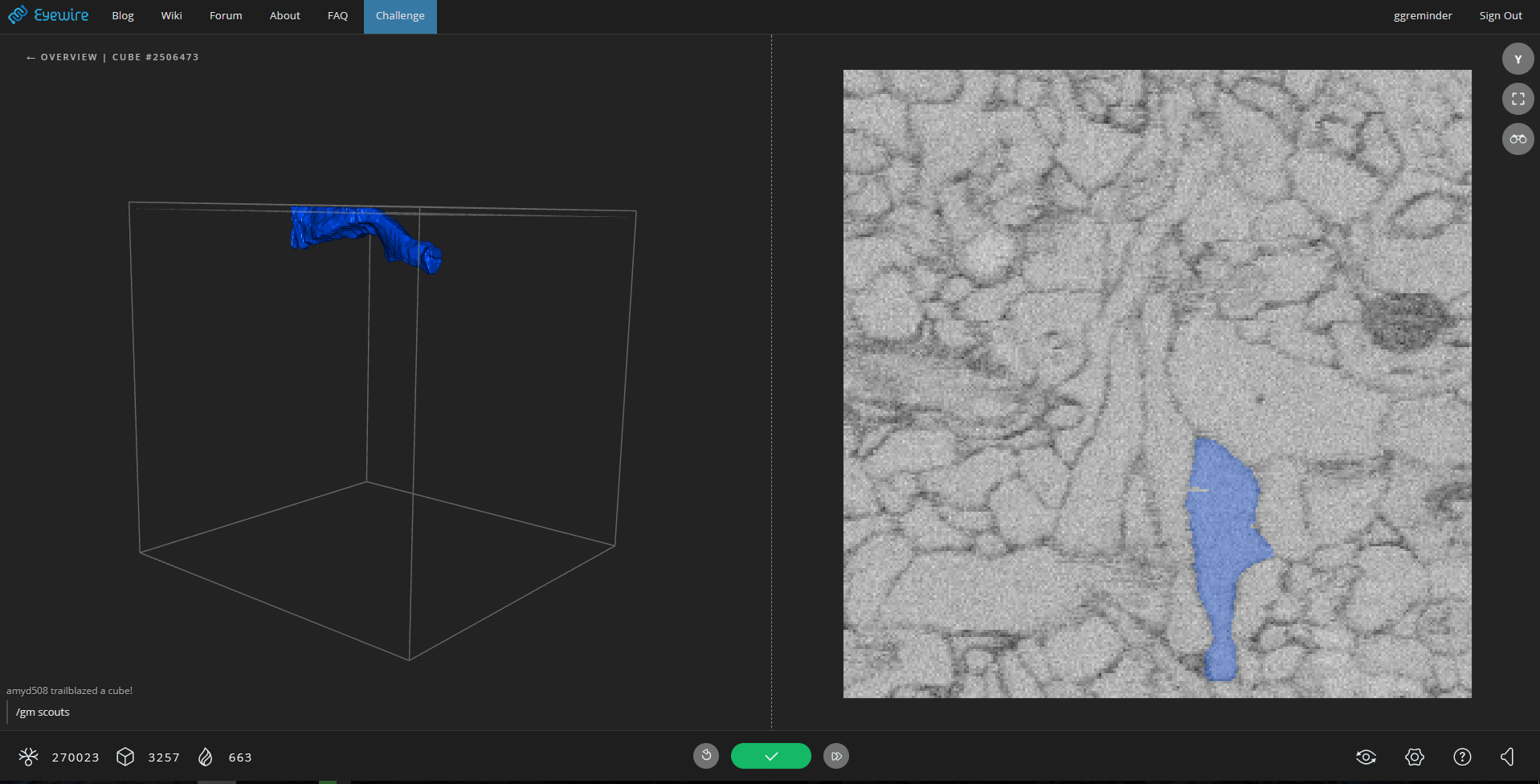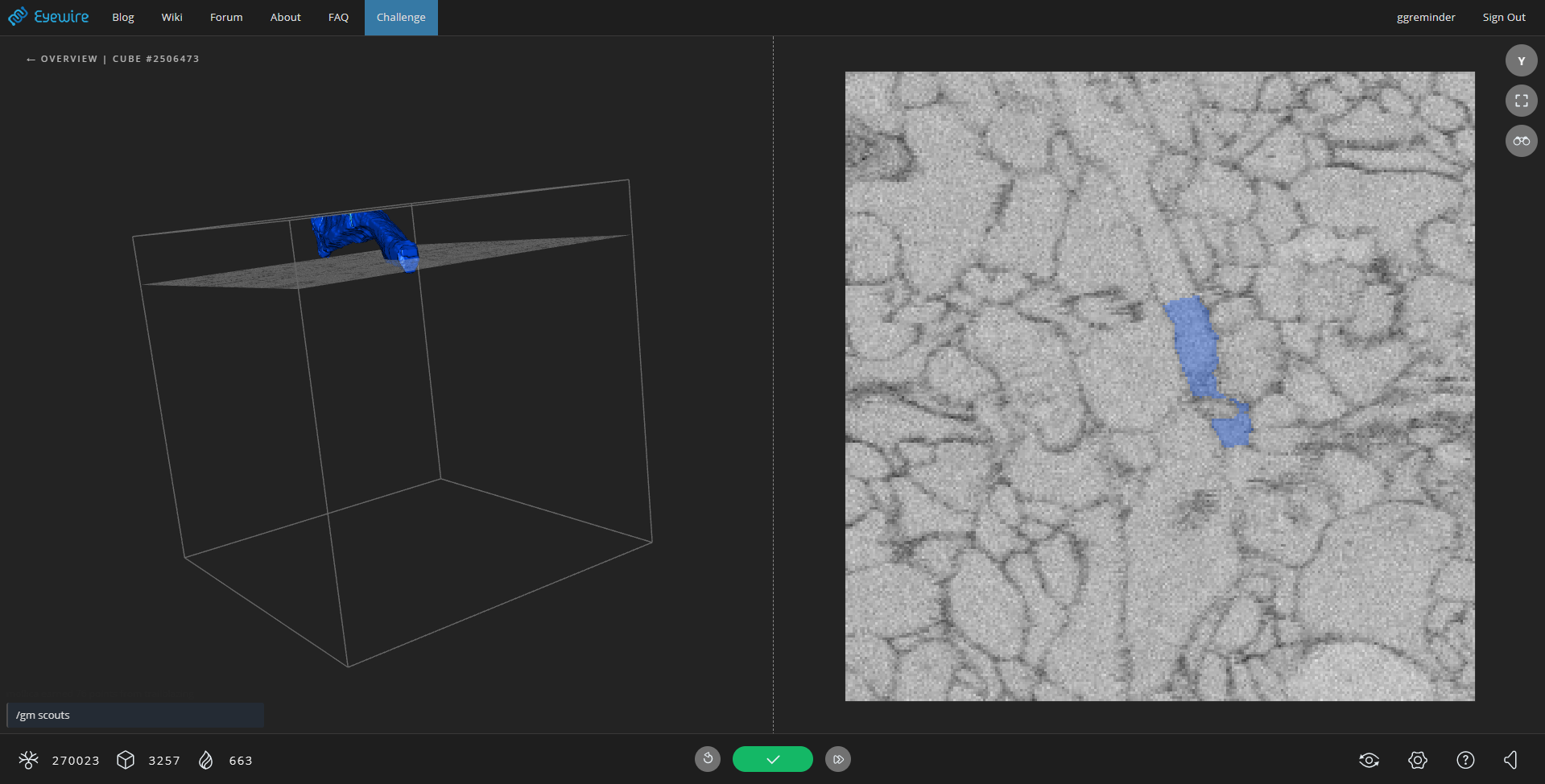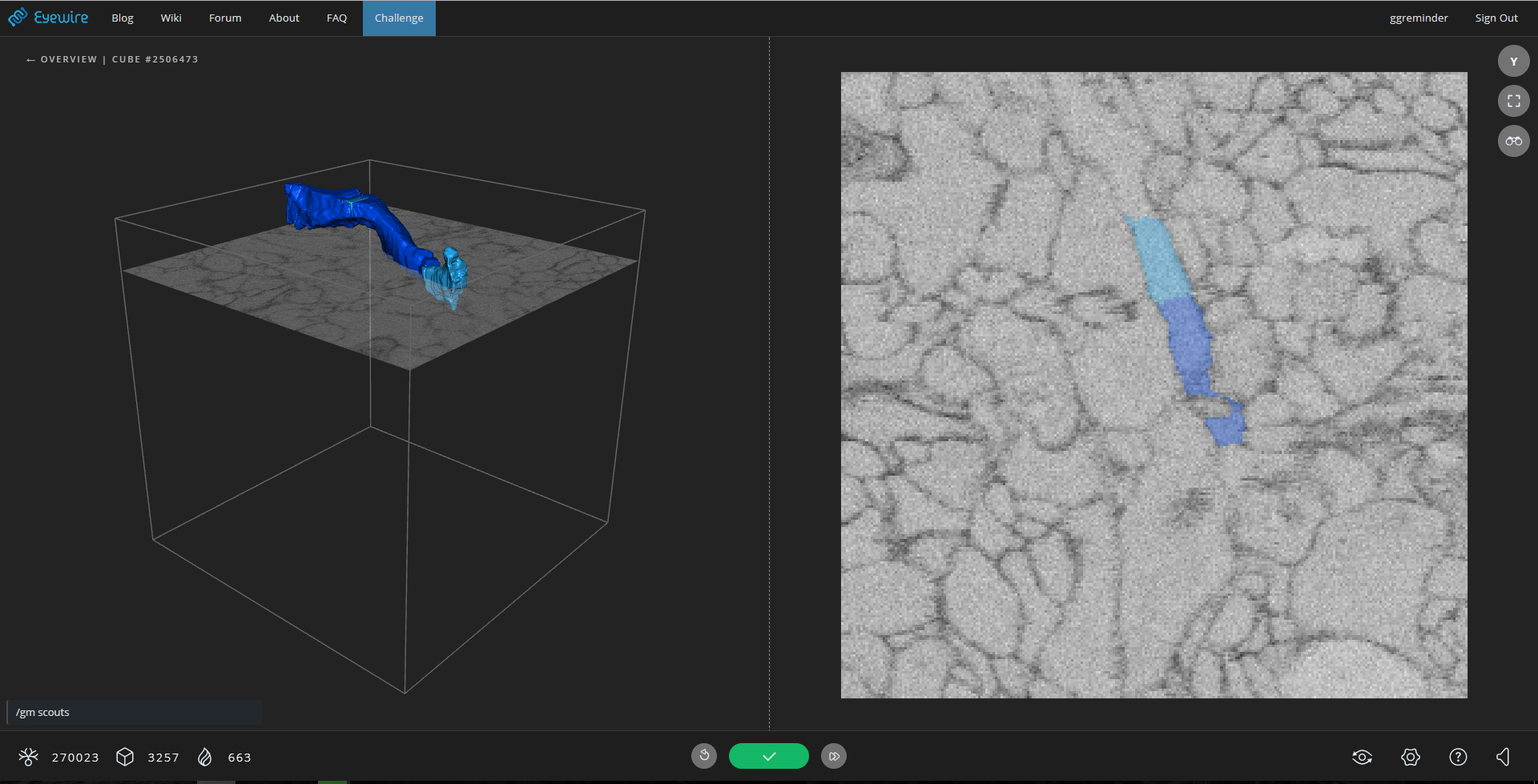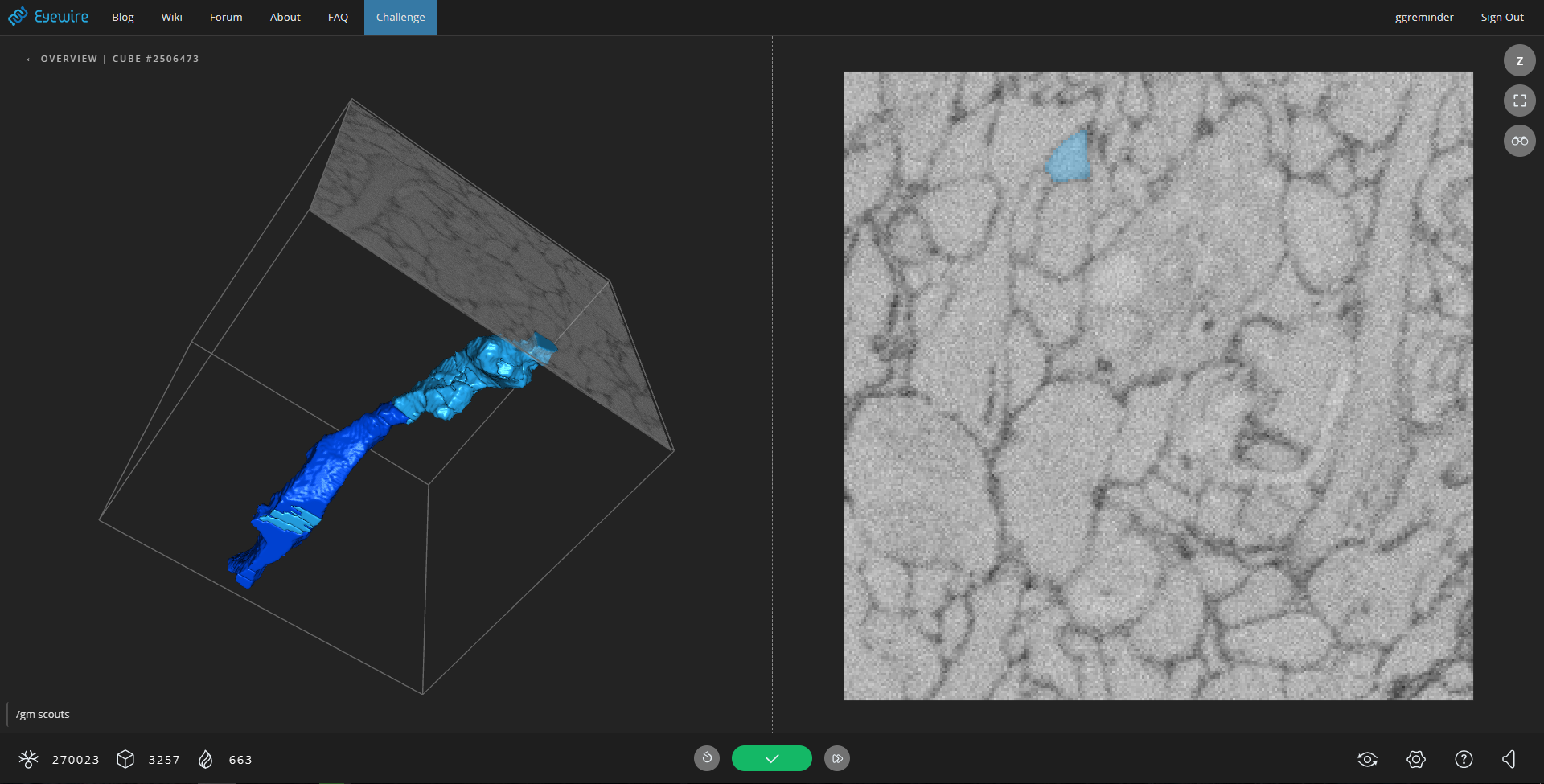EyeWire is a brain simulation game.
Hello! I would like to talk here about the EyeWire project. But first - a couple of words about what constitutes "social" science (citizen science).

Many of you will remember such a platform as BOINC ( an article on Geektimes , a news about BOINC for Android ). Now her popularity seems to have decreased, but a number of projects are still active, for example, Einstein @ Home - searching for gravitational waves from compact objects according to data from the LIGO telescope. The essence of participation there was to install the software on one computer that processes the calculations for one or several projects and send the results to the server. The total computing power of many desktop computers is quite large, but slightly inferior to top-end supercomputers. For example, for 2013, the BOINC platform had a speed of about 9 PFlops, and the newest supercomputer (Tianhe-2) - 33 PFlops, that is, ~ 3.5 times faster. Today, the gap is somewhat larger: at BOINC, the speed doubled (up to 18 PFlops), and supercomputers are already very close to the level of 100 PFlops and Exaflops-supercomputers are designed (1 EFlops = 1000 PFlops = 1000000 TFlops). Nevertheless, some results of the calculation have been given, and if you wish, I will review such results and their application in the real world.
An alternative to donating computer time is more active participation of the person himself in the projects. An example of such a manifestation of "social" science - projects GalaxyZoo. The project started in 2007 and still has a fairly large number of fans. Now I was not looking for numbers, but a number of projects noted a significant excess of activity over expected - for example, the very first project on classification had about 70,000 classifications per hour. These projects mainly use the ability of the human brain to find patterns (images similar to others). While the program needs to prescribe the entire evaluation logic, often in fine detail, a person can evaluate the picture as a whole, while ignoring image defects and discrepancy between the axis of the depicted object and the picture plane (in other words, when the object is deployed in space and is seen from the side or at some angle). It is believed that the simple people trained in the examples, who do not have academic degrees, can draw conclusions on the contents of images (for example, to distinguish an elliptical galaxy from a spiral galaxy) not statistically worse than the scientists themselves. Initially, the Galaxy Zoo projects were astronomical in nature, and later a large number of projects from other fields of science were launched on the same engine - from searching for sea creatures or animals in photos to reading the shipbooks of the British Royal Navy (the project itself, Old Weather, had a goal to restore weather data of the early 20th century).
Finally, the project I want to talk about involves the participant much more - it has a part of the game (with an indispensable “honor roll” and all sorts of status icons), a part of a social network (quite active chat with cute discussions as what we are doing, and talking about life) and part of science (with scientific publications with the indispensable co-author Dr The EyeWirers).
EyeWire is a project to restore the 3D structure and neuron connectivity in the mouse brain, or rather, the part that is connected with the eye (the so-called “connection”). Of course, I would like to know how this part of the brain is arranged in a person, but his brain is much more complicated and, more importantly, no one will cut a healthy brain into slices. Like the Galaxy Zoo, EyeWire doesn’t have a long period of reading instructions - you can start within minutes after registration (nothing except the login, password and mail will not be asked).
The big green “Start Playing” button - and forward to the path of science! Here is a screenshot of the interface in the "review" mode.

On the left is the same button, in the center of the 3D preview of a simple cell (here jokingly called "mustache" - English mustache cell), to the right is the "honor roll". After entering the game mode, you get inside one of the randomly selected "cubes" - the data set areas where the branches (dendrites) of our cell are located.

The game engine, on the basis of data about the “cubes” of the neighbors, builds a preliminary model of that part of the dendrite that passes through the “cube”. You can see sharp edges, breaks - this is characteristic of an incomplete model. Our task is to complete it. At the same time, it is important to fill in as accurately as possible the areas related to the dendrite (because any of them can give rise to another process), and try not to capture extra data, otherwise we will include a completely different cell in the model (this is called "merging" - English . merger). For convenience, the model is immediately rendered when you add a fragment on a plane. The first picture shows that the shaded field has a space, we also paint over it, but more important is another area that will allow us to complete the dendrite. Here he is:

After painting, the part first appears:

Then we add the rest, clicking on other light areas, and not going beyond the black lines (borders of the dendrites on the slice) To make sure that the model is complete, go higher and lower in the plane, if necessary, change the plane to another (click on the toolbar in the right top corner or D key. Final View:

We send cube. Get points and go to the next cube. For beginners, the authors of EyeWire have come up with a special interactive script that shows the correctness of the work done in real time (and not after sending the cube), this simplifies the initial stage. If you work well with 3D structures and it’s too easy for you, don’t worry: only simple cells are available for beginners, but you can choose another one and, after an additional training scenario, go to work in cells of the second type:

I think this is enough for the first time. I will be glad to see you in the vast EyeWire! If there is interest in the article, I can tell you a little more about what happens after the cell model has been built, as well as about even more complex parts of the game - where scouts are looking for missing branches or merges, and scythe (English scythe) data to the final result.
For those interested: in addition to EyeWire, there is a Mozak Brainbuilder project (found it when preparing the article) - currently in beta, it is proposed to build models of neurons by drawing broken lines from the photo, the detailing is much lower than EyeWire, but the requirements are not so significant. There is also a project to search for 3D structures of Fold.It proteins for more precise drug targeting.
Thanks for attention!
UPD: Added KDPV.
UPD2: Thank you Mad__Max , fixed a bug in the units of measurement of supercomputer performance

Many of you will remember such a platform as BOINC ( an article on Geektimes , a news about BOINC for Android ). Now her popularity seems to have decreased, but a number of projects are still active, for example, Einstein @ Home - searching for gravitational waves from compact objects according to data from the LIGO telescope. The essence of participation there was to install the software on one computer that processes the calculations for one or several projects and send the results to the server. The total computing power of many desktop computers is quite large, but slightly inferior to top-end supercomputers. For example, for 2013, the BOINC platform had a speed of about 9 PFlops, and the newest supercomputer (Tianhe-2) - 33 PFlops, that is, ~ 3.5 times faster. Today, the gap is somewhat larger: at BOINC, the speed doubled (up to 18 PFlops), and supercomputers are already very close to the level of 100 PFlops and Exaflops-supercomputers are designed (1 EFlops = 1000 PFlops = 1000000 TFlops). Nevertheless, some results of the calculation have been given, and if you wish, I will review such results and their application in the real world.
An alternative to donating computer time is more active participation of the person himself in the projects. An example of such a manifestation of "social" science - projects GalaxyZoo. The project started in 2007 and still has a fairly large number of fans. Now I was not looking for numbers, but a number of projects noted a significant excess of activity over expected - for example, the very first project on classification had about 70,000 classifications per hour. These projects mainly use the ability of the human brain to find patterns (images similar to others). While the program needs to prescribe the entire evaluation logic, often in fine detail, a person can evaluate the picture as a whole, while ignoring image defects and discrepancy between the axis of the depicted object and the picture plane (in other words, when the object is deployed in space and is seen from the side or at some angle). It is believed that the simple people trained in the examples, who do not have academic degrees, can draw conclusions on the contents of images (for example, to distinguish an elliptical galaxy from a spiral galaxy) not statistically worse than the scientists themselves. Initially, the Galaxy Zoo projects were astronomical in nature, and later a large number of projects from other fields of science were launched on the same engine - from searching for sea creatures or animals in photos to reading the shipbooks of the British Royal Navy (the project itself, Old Weather, had a goal to restore weather data of the early 20th century).
Finally, the project I want to talk about involves the participant much more - it has a part of the game (with an indispensable “honor roll” and all sorts of status icons), a part of a social network (quite active chat with cute discussions as what we are doing, and talking about life) and part of science (with scientific publications with the indispensable co-author Dr The EyeWirers).
EyeWire is a project to restore the 3D structure and neuron connectivity in the mouse brain, or rather, the part that is connected with the eye (the so-called “connection”). Of course, I would like to know how this part of the brain is arranged in a person, but his brain is much more complicated and, more importantly, no one will cut a healthy brain into slices. Like the Galaxy Zoo, EyeWire doesn’t have a long period of reading instructions - you can start within minutes after registration (nothing except the login, password and mail will not be asked).
The big green “Start Playing” button - and forward to the path of science! Here is a screenshot of the interface in the "review" mode.

On the left is the same button, in the center of the 3D preview of a simple cell (here jokingly called "mustache" - English mustache cell), to the right is the "honor roll". After entering the game mode, you get inside one of the randomly selected "cubes" - the data set areas where the branches (dendrites) of our cell are located.

The game engine, on the basis of data about the “cubes” of the neighbors, builds a preliminary model of that part of the dendrite that passes through the “cube”. You can see sharp edges, breaks - this is characteristic of an incomplete model. Our task is to complete it. At the same time, it is important to fill in as accurately as possible the areas related to the dendrite (because any of them can give rise to another process), and try not to capture extra data, otherwise we will include a completely different cell in the model (this is called "merging" - English . merger). For convenience, the model is immediately rendered when you add a fragment on a plane. The first picture shows that the shaded field has a space, we also paint over it, but more important is another area that will allow us to complete the dendrite. Here he is:

After painting, the part first appears:

Then we add the rest, clicking on other light areas, and not going beyond the black lines (borders of the dendrites on the slice) To make sure that the model is complete, go higher and lower in the plane, if necessary, change the plane to another (click on the toolbar in the right top corner or D key. Final View:

We send cube. Get points and go to the next cube. For beginners, the authors of EyeWire have come up with a special interactive script that shows the correctness of the work done in real time (and not after sending the cube), this simplifies the initial stage. If you work well with 3D structures and it’s too easy for you, don’t worry: only simple cells are available for beginners, but you can choose another one and, after an additional training scenario, go to work in cells of the second type:

I think this is enough for the first time. I will be glad to see you in the vast EyeWire! If there is interest in the article, I can tell you a little more about what happens after the cell model has been built, as well as about even more complex parts of the game - where scouts are looking for missing branches or merges, and scythe (English scythe) data to the final result.
For those interested: in addition to EyeWire, there is a Mozak Brainbuilder project (found it when preparing the article) - currently in beta, it is proposed to build models of neurons by drawing broken lines from the photo, the detailing is much lower than EyeWire, but the requirements are not so significant. There is also a project to search for 3D structures of Fold.It proteins for more precise drug targeting.
Thanks for attention!
UPD: Added KDPV.
UPD2: Thank you Mad__Max , fixed a bug in the units of measurement of supercomputer performance
All Articles